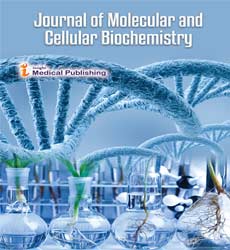Low-Density Lipoprotein and its Related Problem
Mike Hawkins*
Department of Biochemistry, University of Lagos, Lagos, Nigeria
- *Corresponding Author:
- Mike Hawkins
Department of Biochemistry,
University of Lagos,
Lagos,
Nigeria
E-mail: mike.hawkins2010@port.ng
Received Date: November 04, 2021; Accepted Date: November 18, 2021; Published Date: November 25, 2021
Citation: Hawkins M (2021) Low Density Lipoprotein and its Related Problem. J Mol Cell Biochem Vol.5 No.5:011.
Description
Cholesterol is a fatty molecule present in all cells that serves various functions, including aiding in the formation of new cells in the body. It is linked with proteins and travels through the bloodstream. Lipoprotein is the term given to these proteins. There are various forms of cholesterol, each of which is composed of lipoproteins and lipids. Each form of lipoprotein includes different levels of cholesterol, protein, and triglycerides. LDL cholesterol, also known as low-density lipoprotein cholesterol, is a form of lipid that circulates in the bloodstream, transporting cholesterol across the body to where it is required for cell repair and deposited it inside artery walls. Because cholesterol and triglycerides are insoluble in water, they need to be bound to proteins in order to circulate in the hydrophilic blood. Triglycerides make up almost half of a VLDL particle. Lipoproteins (LDL and HDL) are two forms of lipoproteins. They are made up of fat (lipid) and protein. To flow through the blood, the lipids must be linked to the proteins. LDL and HDL provide various functions.
Very-Low-Density Lipoprotein (VLDL) cholesterol is synthesized in the liver and delivered into the bloodstream to provide a kind of lipid to cells in the body (triglycerides). High amounts of Low-Density Lipoprotein (LDL) can accumulate inside the walls of the blood vessels, narrowing the airways. A clot can form and become lodged in the restricted space, resulting in a heart attack or stroke. As a result, LDL cholesterol is frequently referred to as "bad" cholesterol. LDL cholesterol is known as "bad" cholesterol because it contributes to fatty accumulation in the arteries (atherosclerosis). This causes arterial narrowing and raises the risk of heart attack, stroke, and Peripheral Artery Disease (PAD). Very Low-Density Lipoprotein (VLDL) is produced by the liver and is converted to IDL by Lipoprotein Lipase (LPL). LDL oxidation is proinflammatory and proatherogenic, and it is directly involved in the development, progression, and help in destabilisation of atherosclerotic lesions. Endothelial cells are stimulated by minimally oxidised LDL to release chemokine and other factors that are responsible for monocyte recruitment and penetration into the artery wall, as well as monocyte/ macrophage proliferation and differentiation.
When LDL particles are further oxidised, they are preferentially taken up by macrophage cells scavenger receptors, resulting in the production of foam cells. Preclinical atherosclerosis, coronary arterial atherosclerosis, acute coronary syndrome, and susceptible plaques are all linked to circulating oxidised LDLs. As a result, it has been proposed that dietary supplementation with antioxidants such as quercetin could be a potential technique for lowering the risk of atherosclerosis. Quercetin and quercetin-3-O-glucuronide protect LDL against neutrophil-mediated modification, mostly by inhibiting myeloperoxidase, and so may reduce the risk of atherosclerosis. Diabetes, hypertension, hypertriglyceridemia, and atherosclerosis are all typically connected with it. Hypercholesterolemia, which is normally asymptomatic, may appear with metabolic syndrome, in which the patient has hypertension. Patients with severe hypercholesterolemia may develop xanthomas with yellow nodules or plaques on the Achilles tendon. Lowering triglycerides is the most effective strategy to lower VLDL cholesterol. Losing weight and exercising consistently are essential, and you should avoid sugary foods and alcohol in particular. Medications can also be beneficial.
Open Access Journals
- Aquaculture & Veterinary Science
- Chemistry & Chemical Sciences
- Clinical Sciences
- Engineering
- General Science
- Genetics & Molecular Biology
- Health Care & Nursing
- Immunology & Microbiology
- Materials Science
- Mathematics & Physics
- Medical Sciences
- Neurology & Psychiatry
- Oncology & Cancer Science
- Pharmaceutical Sciences
